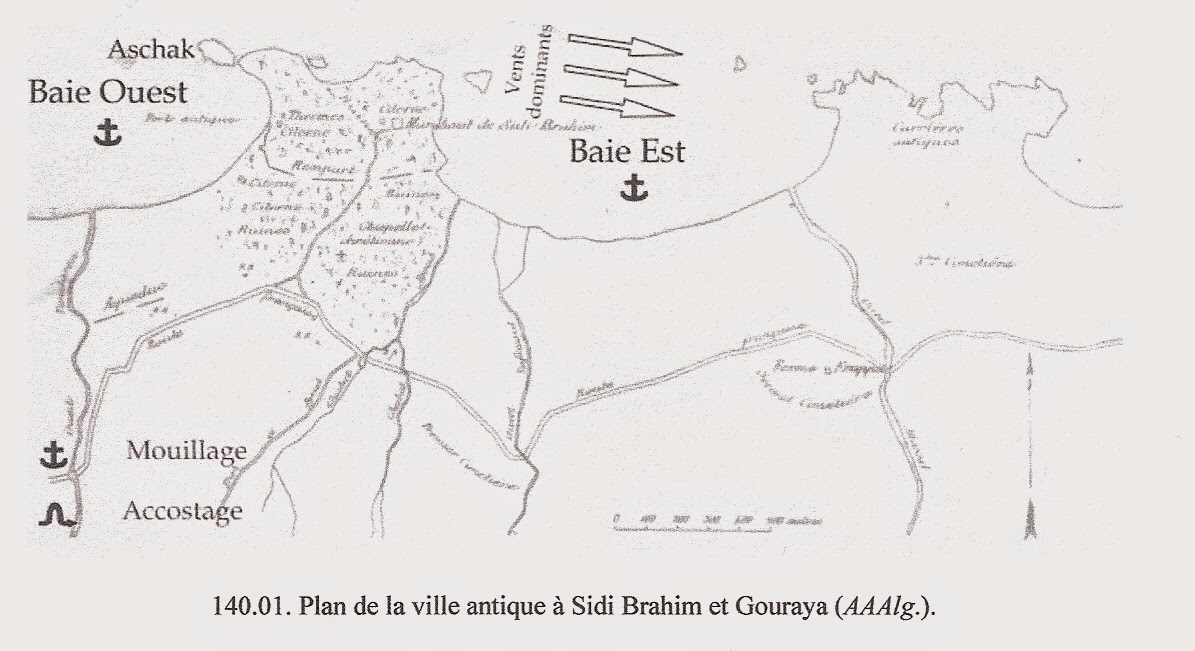GUNUGU
This
Phoenician settlement is located 33 km west of Cherchel in Algeria
The
Phoenician name of the settlement is not directly known, but an attempt to find
it in Punic can be made by the following information:
The town is
mentioned by
- Plinius
(NH V, 20) > Gunugu is a colony of Augustus;
- CIV VIII 9071,
9423;
- Ptolemeus (IV
2,5) κανουίς ;
-
It.Ant.(p.15) resp(tiblica) G(unugitanomm);
- Coin from
Bocchus II of Mauretania with neo-Punic
letters : g n g n.
The name
Gunugu could be Libyco-Berber. We find g n w k n in the inscription CIS I
1443,3 and the corresponding K N K N in the inscription RIL 627. K.Jongeling
gives a survey of all the Berber names ending on –kn op p.60-61 of his
dissertation Personal names in neo-Punic inscriptions.
Excavations
of the three necropolis have attested the existence of a pre-roman settlement
of certainly the 3rd and 2nd century BC. The presence of
Attic pottery proves however that the beginning of the settlement goes back at
least to the 5th century BC. See: F.Villard (1959).
We find two
necropolis on the eastern bay near Sidi Brahim and another on cape, which
separates the western and eastern bay. In 1900 S.Gsell digs up the so-called
“maison du charbonnier” = house of the charcoal-burner. It is a pit of 2 meters
deep, without a staircase and a room nect to it for the deceased.
Shipping
and trade.
-----------------------
Gunugu had
overseas connections with Sicily and Spain and even with Lixus on the coast of Morocco
Maybe it
has something to do with the pattern of colonisation by the Phoenicians.
Briefly: In the beginning they took the northern route along Crete – Sicily – Sardinia to Spain Spain Lebanon ,
then it was necessary to reinforce the settlements halfway in Africa, Sicily and Sardinia in 6th-4th
century BC. Most of the North-African Phoenician settlements as permanent towns
begin in the 6th century, but Gunugu is an exception. The beginning
here start at least a century earlier. I could elaborate much more about this,
but here it is enough to understand, why the spread of the art of ostrich
egg-shell painting went probably from Villaricos in Spain
Ostrich
egg-shells.
=============
Gunugu is a
centre for the painting and decoration of ostrich egg-shells. The town joins a
very old tradition, that started already before 3000 BC at Bahrein! From there
it spread to Sumeria -> Syria
–> Lebanon and by the
Phoenicians all over the Mediterranean .
Outstanding are the tombs of Djidjelli and Gouraya, with a rich series of the
receptacle type with undecorated whole shells and three-quarter shells. The
Gouraya examples are interesting for the iconographical repertoire painted on
the three quarter shells. The geometrical and floral motifs, similar to those
found at Carthage
The
geometric pattern and even signs/marks are almost the same, as we can see in
Villaricos in Spain
Inscriptions.
=========
Gunugu is a
remarkable settlement, because we find there also the incredible amount of at
least 22 neo-Punic inscriptions. K.Jongeling traces down the personal names: g
n s (N17),
g s m? (N18), z b
y g y s/š (N9), y g y š w m (N12), m g w Ṣ (N11). See : Personal names in neo-Punic
inscriptions, Groningen
There has
also been found an Etruscan inscription, engraved on a bronze disk, at Sidi
Brahim. It comes from the 3rd century BC. You can read here
(p)unicum Lartha. See:
Y.Liebert, Une inscription étrusque d’Algérie, Revue des Etudes Latines 74
(1996) p.38-46.
Some
history :
Literature :
S.Gsell,
Fouilles de Gouraya, HAAN II,
p.161-162, Paris
F.Missonier,
Fouilles dans la nécropole de Gouraya, Melanges de l’école francaise de Rome 50
(1933) p.87-119.
M.Astruc,
Supplément aux fouilles de Gouraya, Libyca 2 (1954) p.9-48.
Mazard, Corpus
Nummorum Numidiae Mauretaniarque, p.172-173, Paris 1955.
F.Villard, Vases
attique du Ve siècle av.J.C.à Gouraya, Libyca 7 (1959) p.7-13.
Lepelley, les
cités de l’Afrique romaine du Bas Empire, Paris, 1979-1981.
Leschi, Fouilles
de la nécropole punique de Gouraya, BCTH 1932-1933, p.277-278.
ncfps




Geen opmerkingen:
Een reactie posten